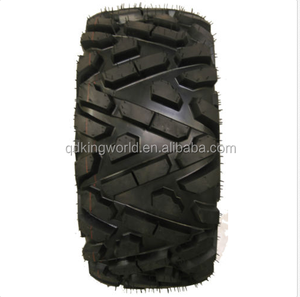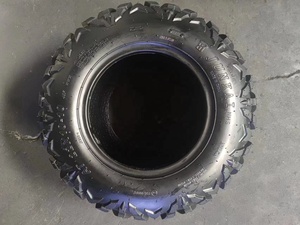(20451 products available)











































































































































































ATV tires are available in different categories, depending on the terrain they are designed to cover. Here are the different types of all-terrain vehicle tires:
ATV tire specifications are designed to meet various riding needs. Here are the common specifications:
Tire size
ATV tire sizes are given in three measurements separated by slashes. The primary number shows the tire's width in millimeters. The second number is the aspect ratio, which shows the tire's elevation concerning its width. The last number shows the wheel's internal measurement in inches. This size offers a great balance between traction and agility.
Tread pattern
Different tread designs offer various benefits. Aggressive treads with deep, widely spaced lugs provide maximum grip in mud and rough terrain. The all-purpose tread combines on-road and off-road performance, making it suitable for various surfaces. The flat track design focuses on smooth tracks, offering low rolling resistance and adequate grip.
Tread depth
Tread depth affects traction and tire longevity. Tires with lower depths deliver better performance on tracks, while those with greater depths are suitable for muddy terrains.
Load rating
The load rating indicates the maximum weight the tire can carry. It is essential when considering towing or carrying cargo. Exceeding the load rating can cause premature wear or tire failure.
Speed rating
The speed rating shows the maximum speed the tire can perform safely. For ATV tires, speed ratings confirm stability and grip at high speeds on various terrains.
Maintaining ATV brands' tires is essential to ensure safety and optimize performance. Here are the steps.
Regular inspection
Inspect the tires for damages such as punctures, cuts, or tears. Also check for embedded objects like sharp stones or metals. Examine the sidewalls and tread for uneven wear or bulges, which may indicate internal tire damages.
Tire pressure
Ensure the tire pressure is as per the manufacturer's instructions. Use a pressure gauge to inspect the pressure before and after rides. Proper inflation prevents blowouts, ensures even tread wear, and improves fuel efficiency.
Tread depth
Monitor the tread depth using a tread depth gauge or a simple coin test. Replace the tires when the depth wears out, as low tread depth compromises traction, especially in wet or slippery grounds.
Rotation
To ensure even wear, rotate the tires according to the manufacturer's guidelines. This practice prolongs tire life and improves handling and stability.
Cleaning
Remove dirt, mud, and debris from the tires after every ride. A stiff brush and a garden hose will do the work. This prevents the buildup of materials that can cause uneven wear or punctures.
Storage
During the off-season, store the ATV tires in a cool, dry place away from direct sunlight and heat sources. Also, keep them away from chemicals and oils that can damage the rubber compound.
Tire balancing and alignment
Get the tires aligned and balanced regularly. Proper alignment and balancing prevent vibrations, enhance handling, and ensure even tread wear.
With the many options available in the market, choosing the right ATV tire can be a daunting task. Here are some tips that can help in choosing the right ATV tire:
Consider the type of terrain:
When selecting an ATV tire, consider the terrain the tire will be used. For off-mud riding, the tires with deeper, more aggressive treads that can claw through the mud and tires are better for hard-packed trails and racing.
Understand the riding style:
Buyers should consider their riding styles when choosing tires. Buyers who ride aggressively and at high speeds need sportier tires that can handle the demands, while casual trail riders can settle for more versatile, budget-friendly options.
Brand reputation:
Buyers should go for well-known brands that are reputable in producing high-quality ATV tires. Reliable brands may offer consistent performance, durability, and quality, which may be advantageous in the long run.
Budget:
Buyers should consider their budget before purchasing an ATV tire. Tires with aggressive tread patterns and specialty designs are more expensive than those with mild tread patterns. Additionally, high-quality tires last longer, which may be more cost-effective in the long run.
Changing an ATV tire is a simple and straightforward process. First, list the tools needed for the task. These include:
Once the tools have been acquired, replace the tires by following these steps:
1. Prepare the ATV
Find a flat and level ground to park the ATV. Engage the parking brake. Then, using the jack, lift the ATV before placing it on the jack stands.
2. Remove the wheels
Using the lug wrench, remove the lug nuts and take out the wheels by turning the wheels.
3. Remove the old tires
Deflate the old tires completely by removing the valve cores using the valve core tool. The air will release with a hissing sound. Next, use the bead breaker or tire levers to separate the tires from the wheels. This is done by breaking the bead and loosening the bead, respectively.
4. Install new tires
Lubricate the new tires' beads and the wheel's edges. Then, use the tire irons to insert the new tires onto the wheels. Ensure the bead is seated properly. Once the new tires are installed, inflate them to the recommended pressure.
5. Reattach the wheels
Put the wheels back onto the ATV and screw the lug nuts by hand. Lower the ATV and tighten the nuts using the lug wrench.
Q1: How long do ATV tires last?
A1: ATV tires have different durations depending on the type and usage. Generally, they last between 2 to 5 years. However, buyers can tell when tires are worn out to replace them before they affect performance.
Q2: Can buyers order customized ATV tires?
A2: Yes, buyers can get customized ATV tires. Buyers should contact the supplier to get the desired specifications and customization options.
Q3: What are the maintenance tips for ATV tires?
A3: To keep the tires in good shape, proper maintenance is required. Some of the maintenance tips are: 1. Proper inflation- always check the pressure before and after a ride. 2. Regularly examine the tires for signs of wear, damage, or punctures. 3. Clean the tires after every ride, especially in muddy or sandy terrains, to remove debris and minimize wear. 4. Rotate the tires to promote even wear and prolong tire life. 5. Use appropriate tires for specific terrains to avoid premature wear and tear.